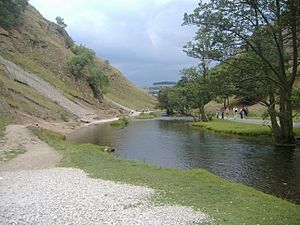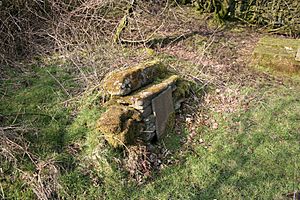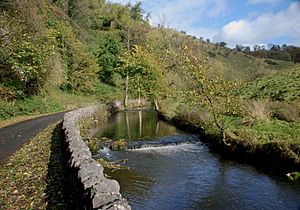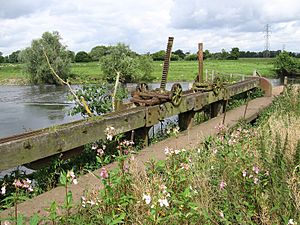River Dove, Central England facts for kids
Quick facts for kids Dove (Derbyshire & Staffordshire) |
|
|---|---|
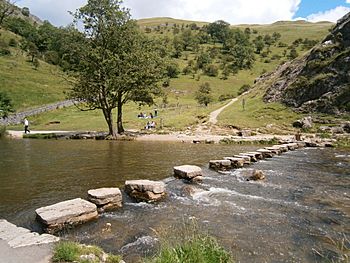
The stepping stones over the River Dove, Dovedale
|
|
| Country | England |
| Region | Staffordshire, Derbyshire |
| District | Beresford Dale, Wolfscote Dale, Milldale, Dovedale |
| Physical characteristics | |
| Main source | Dove Head Axe Edge Moor, Peak District, England 84 m (276 ft) 53°13′N 1°57′W / 53.217°N 1.950°W |
| River mouth | Newton Solney, Derbyshire, England 52°49′N 01°35′W / 52.817°N 1.583°W |
| Length | 72 km (45 mi) |
| Basin features | |
| Tributaries |
|
The River Dove is a famous river in the southwest Peak District of England. It is about 72 kilometers (45 miles) long. The river starts high up on Axe Edge Moor near Buxton. It then flows south until it meets the River Trent at Newton Solney. From there, its water travels to the North Sea through the Humber Estuary.
For almost its entire journey, the River Dove forms the border between two counties: Staffordshire (on the west side) and Derbyshire (on the east side). The river winds its way past towns like Longnor and Hartington. It also carves out deep limestone valleys, which are like narrow canyons. These include Beresford Dale, Wolfscote Dale, Milldale, and Dovedale.
The River Dove is well-known for its trout fish. There's a special building called Charles Cotton's Fishing House by the river near Hartington. This place inspired a famous book about fishing called The Compleat Angler by Izaak Walton.
Most people today say "Dove" so it rhymes with "love." But originally, it rhymed with "rove." Some people who live near the lower part of the river still use the older pronunciation.
Contents
Exploring Dovedale's Beauty
From Hartington to where it meets the River Manifold at Ilam, the River Dove flows through a series of beautiful limestone valleys. These valleys are together known as Dovedale. The name Dovedale is also used specifically for the section between the famous stepping stones under Thorpe Cloud and Milldale.
The Dovedale valley is so incredibly scenic that it attracts about a million visitors every year! There are good paths along the riverside, making it easy for walkers to explore the whole route.
Much of Dovedale is owned by the National Trust, which is a charity that protects special places. Dovedale itself was bought by the National Trust in 1934. More land was added until 1938, and Wolfscote Dale was added in 1948. In 2006, Dovedale was officially named a national nature reserve.
Some of the cool things to see in Dovedale include tall rock pillars like Ilam Rock and Viator's Bridge. There are also interesting limestone features like Lovers' Leap and Reynard's Cave.
The River's Journey: Lower Dove
Once the River Dove leaves Dovedale, it joins with the Manifold. The valley then becomes wider as the river continues south towards Mapleton and Mayfield. At Mayfield, an old medieval bridge called Hanging Bridge crosses the river. Here, the Bentley Brook joins the Dove, followed by the Henmore Brook nearby at Church Mayfield.
The Dove then flows southwest, passing Norbury and Ellastone. It turns south until it reaches Rocester. South of Rocester, at Combridge, the river is joined by its largest tributary, the River Churnet. As it reaches the ancient Dove Bridge, the River Tean also joins. The river then winds through a wide valley, turning east as it flows between Doveridge and Uttoxeter. Uttoxeter is the only town located directly along the river's path.
Beyond Uttoxeter, villages like Marchington, Sudbury, and Scropton are usually found on the edge of the valley. However, the village of Hatton stretches across the valley floor. It is connected by a bridge to Tutbury, where Tutbury Castle looks down over the river crossing. The river continues east, passing the villages of Marston, Rolleston, and Egginton. Here, its last tributary, the Hilton Brook, joins it.
At this point, the river splits, with some water flowing through a channel called a mill fleam at Clay Mills. The two parts of the river rejoin downstream of the A38 road bridge and Monks Bridge. Finally, to the south, the River Dove meets the River Trent at Newton Solney.
River Dove's Tributaries
Many smaller rivers and streams flow into the River Dove. These are called tributaries. Here is an alphabetical list of some of them:
- Alders Brook (joins near Rocester)
- Bentley Brook
- River Churnet
- Foston Brook (joins near Rocester)
- Henmore Brook
- Hilton Brook
- River Manifold
- Marchington Brook (joins near Marchington)
- Marston Brook (joins near Marchington)
- Picknall Brook (joins near Uttoxeter)
- Rolleston Brook (joins near Rolleston on Dove)
- River Tean
- Tit Brook (joins near Ellastone)
See also
 In Spanish: Río Dove (Inglaterra central) para niños
In Spanish: Río Dove (Inglaterra central) para niños


